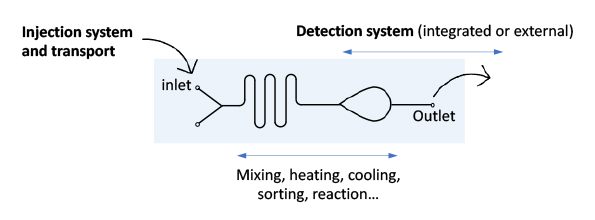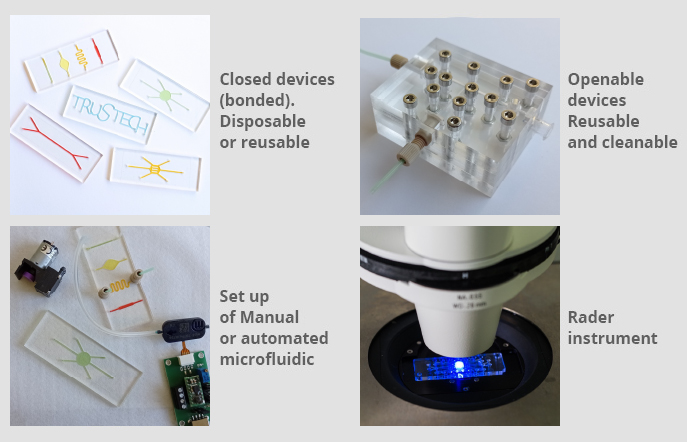Microfluidics and LOC
Microfluidics and LOC
Lab on Chip (LOC) are miniaturized microfluidics devices able to execute complex laboratory protocols. LOCs integrate multiple laboratory functions on few square centimeters handling extremely small fluid volumes (μl to pl)
The advantages of miniaturization are:
- Minimal reagent consumption
- Low reaction volumes
- High surface-to-volume ratio (Reduction in reaction time, high heat and mass transfer, that means fast heating, cooling and diffusion)
- High yields, reproducibility and robustness
- Good handling of droplets

Due to their features, LOC are one of the cutting-edge technologies in different applications

POINT OF CARE
Diagnostics
High-throughput screening
Drug screening
Forensics
Environmental monitoring
Agrifood and water monitoring

ADVANCED MEDICINE
Personalized medicine
Multi-omics research
Tissue engineering
Organ on chip
Cancer diagnosis
Patient monitoring

RESEARCH
Generation of μ/n particles
Drugs delivery
Biosensors
Microarray
Cell sorting
Cellular culture
We design and realize customized microfluidic device for research and industrial applications
Our service includes different levels of development: from feasibility to industrialization.
We are able to prototype LOCs with different technique and provide integrated microfluidic and detection system for benchtop or portable application.
OUR SUPPORT

DESIGN
Definition of requirements, constraints, geometries and interfaces
3D CAD model

PROTOTYPE AND SMALL APPLICATIONS
Disposable LOC
Reusable LOC
Microfluidic circuit
Reader instrument

FUNCTIONALITY CHECK
Chip sealing, interfaces, valves or other elements
Bio-testing

INDUSTRIALIZATION
Support in the selection of the best technological solutions for large-scale production
Supplier networking

Technique for LOC prototyping
- Milling (PMMA, COC..)
- Soft lithography (PDMS)
- Photolithography e dry o wet etching (Silicon)
Detection options
- Optical (absorbance, fluorescence, chemiluminescence etc)
- Electrical (amperometry, voltammetry, impedance spectroscopy etc)
- Mechanical (quartz crystal microbalance, microcantilever etc)
Case study
Aim of the project
Design and realize a complex microfluidic path able to perform different biochemical protocols. The device was interfacedwith an automated manifold and a optical reader.
Challenges
- Non continuous flow
- Storage of reagents for 6 months without evaporation and migration along channels
- Design, material and process are choiced to achive a balance betwen the required function.
Results
DRIE (Deep Reactive Ion Etching) process have been calibrated especially for this application.
Case study
Aim of the project
Design and realize a complex microfluidic path able to perform different biochemical protocols. The device was interfacedwith an automated manifold and a optical reader.
Challenges
- Non continuous flow
- Storage of reagents for 6 months without evaporation and migration along channels
- Design, material and process are choiced to achive a balance betwen the required function.
Results
DRIE (Deep Reactive Ion Etching) process have been calibrated especially for this application.

REGISTERED OFFICE
Piazza Solferino, 20
10121 Torino
P.I. 11541890015